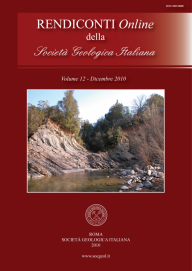
Caratterizzazione geo-ambientale delle Unità di paesaggio del bacino idrografico del Torrente Tammarecchia (Appennino campano-molisano)
Alessio Valente (*), Antonio Di Lisio (*), Elena Cartojan (*) & Filippo Russo (*)
(*) Dipartimento di Studi Geologici ed Ambientali, Università del Sannio, Via dei Mulini 59/A, 82100 Benevento. E-mail: valente@unisannio.it
DOI: https://doi.org/
Volume: 12/2010
Pages: 3-12
Abstract
Geoenvironmental characterization of the landscape units in the hydrographic basin of Tammarecchia Stream (Campanian- Molisan Apennines).
In this paper a methodological approach is proposed in order to define homogenous spatial features, named Landform Unit (Regione Emilia Romagna, 1987), on which apply parameters skilled to characterise morphogenetic processes capable to perturb the environmental system. This approach, developed with the aid of techniques GIS, has been applied to the hydrographic basin of the Tammarecchia Stream on the border of Campania and Molise.
Such a basin is located in the Sannio Mountains, characterised by a succession of ridges with open and flattened highs, lower than 1000 m, and valleys sometimes wide and other times rather narrow. This landscape outlines the lithologies outcropping in the basin, made up essentially by Cenozoic terrigenous deposits (Servizio Geologico d'Italia, 1970a, 1970b; Bonardi et alii, 1988). The distribution of these deposits in the studied area is variable from the arenaceous beds, widely diffuse in the middle and lower part of the basin, to the pelitic and marly beds, mostly present in the higher part of the basin. In these latter deposits are scattered calcareous blocks, as olistoliths. The diffusion of low permeability lithologies has favoured the development of erosive phenomena due to run off (Budetta et alii, 1979).
The landuse could be influenced by this phenomena, which affected this area with different intensity. However, it is concerned mainly to cultivations, that cover a surface more than 73%, and subordinately to woodland, that is extend up to 18%. The rest of the basin is uncultivated (6%) or urbanised (2%).
These data, collected in field survey, photogeological analysis, statistic report and literature, are mapped on a topographic base with 1:25.000 scale. In such way several thematic maps are realized, even if for the proposed approach are utilised only three data base and their representations, such as lithological, acclivity and landuse maps. These ones are overlied, using GIS techniques (Burrough, 1986; Mogorovich & Mussio, 1988), in order to obtain a derived map, where are identified and grouped 7 land units: calcareous olistoliths, summit surfaces, wooden areas, slopes, lower hills, riparian and floodplain.
In order to correlate such landform units to the erosive phenomena we applied to this basin the method of quantitative geomorphic analysis, which permit to evaluate the rate of soil erosion within a hydrographic basin (Ciccacci et alii, 1980, 1988; Del Monte, 1996; Del Monte et alii, 2002; Lupia Palmieri et alii, 1995, 1998, 2001). The degree of organization of drainage network have been considered and quantified by some hierarchical parameters (Rb: Horton, 1945; Rbd, Ga, Δa and Ga: Avena & Giuliano, 1967; Ciccacci et alii, 1980). These parameters put in evidence a poorly organised network because of the peculiar lithology and tectonic condition, especially in the upper and middle part of the basin. The variation of drainage density looks like more significant than the previous parameters, in fact, the lowest values are correlate with very low gradient slopes (e.g. lower part of the basin) and less developed part of network (e.g. areas near to the watershed), whereas the highest values are concentrated in the middle part of the basin as well as along the steeper slopes. A similar distribution is registered for the value of suspended sediment yield (Tu: Ciccacci et alii, 1980). The range is from 6000 t/kmq/year to 40 t/kmq/year, calculated respectively in the middle part of basin and close to the watershed.
According this approach, the Drainage density is an important factor to give a semiquantitative information about the erosion (Del Monte et alii, 2002), the resulting map together with the map of relief energy, overlapped to the map with the landform units, have permitted to reach at a final result, where areas with several rate of instability are identified. More specifically, four classes with increasing rate of instability have been identified. The first class coincide with the following landform units: calcareous olistoliths, summit surfaces, wooden areas, lower hills and partially floodplain. The second class correspond partially to the landform unit of floodplain and to riparian, where the lithology and the sloping are not favourable to generate instability.
Also for the slope unit could be used need the same consideration, where in two area are identified the same rank of Drainage density (i.e. higher) and the same lithology (i.e. marly), a lower gradient could have inhibited the instability.
In the third class and more and more in the fourth, the overlapping clearly show some critical circumstances corresponding to the riparian, where the hydrographic network is greatly disorganised and based on clayey and/or marly lithologies, as well as to the slope unit, where the lithology and/or sloping assist the instability.
The results, evidenced in the synthesis map, are coherent with the observations in the hydrographic basin of Tammarecchia Stream, thus are the support for this approach, which would became a useful instrument for the environmental planning.
Keywords
landscape units, quantitative geomorphic analysis, Geographic Information System, Southern Apennines
Get Full Text